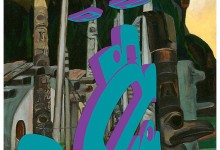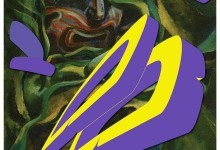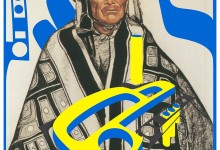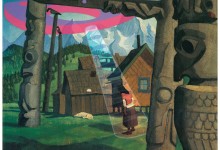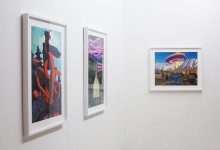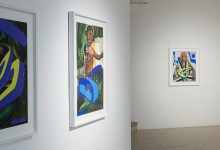Opening reception: Saturday, January 14, 2017 from 3-5 p.m.
Sonny Assu: Interventions On The Imaginary
Art Mûr, Montreal (QC)
Text by Amber Berson
Sonny Assu, a member of the Liǥwildaʼx̱w of the Kwakwaka’wakw nations, uses humour to unsettle dominant cultural expectations of indigenous art while playing with ideas of brand loyalty, consumerism, ready-mades and pop-culture. In 2014 Sonny Assu began thinking about a new project, what would eventually become the Interventions on the Imaginary series. Now comprised of over fifteen pieces and growing, the series playfully challenges the way indigenous presence has been imagined, primarily by settler Canadian artists as a means of promoting a particular vision of Canada. Artists such as the iconic Group of Seven have shaped, for better or worse, dominant narratives in Canadian art, and in many ways landscape painting has become the ‘national’ art. Canada is not, and has never been empty. It is and has always been big, and perhaps even sparsely populated, but never empty.
The works that comprise Interventions on the Imaginary are digital interventions on images of historical works. Most of the references that comprise the backgrounds in the series will be familiar to the viewer – and includes paintings by Emily Carr, A.Y. Jackson, and Edwin Holgate, amongst others. Assu cheekily reinserts an indigenous voice into the work, by literally overlaying his work on top of these historical ones. This gesture acts as a refusal to be historicized exclusively by settler voices, as a means of negating the imagined settler/colonial narrative of an empty Canada and of a vanishing race.
What makes Interventions on the Imaginary so successful is how Assu’s intercessions don’t just make light of the imagined past but tease at an imaginary future. What a Great Spot for a Walmart! (2014), is built on Emily Carr’s Graveyard Entrance, Campbell River (1912), and set in Assu’s current home and his grandmother’s village. In this work, the artist probes the pros and cons of some First Nations communities’ choice to adapt to contemporary realities, while subtly questioning the future consequences of these actions. Similarly, in It was, like, a super long time ago that ppl were here, right? (2014), a digital intervention on Emily Carr’s painting Cumshewa (1912), Assu uses language familiar to the digital native subset to counter the narrative that indigenous struggle is rooted exclusively in the past. At the same time, Assu makes room for new vocabulary to flourish, and consequently for new possible futures to develop.
The pairing of the traditional and the contemporary isn’t new – artists have been creating a dialogue between the past and present for as long as it has been possible to do so. And yet, in the case of Interventions on the Imaginary, the interplay of traditional and imagined First Nations imagery causes the viewer to rethink their ideas of what it means to be First Nations in Canada today. Assu’s work highlights the experience of someone living a dual reality and framed by stereotypical representations that do not define them. By bringing a humorous twist to his work, Assu challenges both stereotype and convention.




